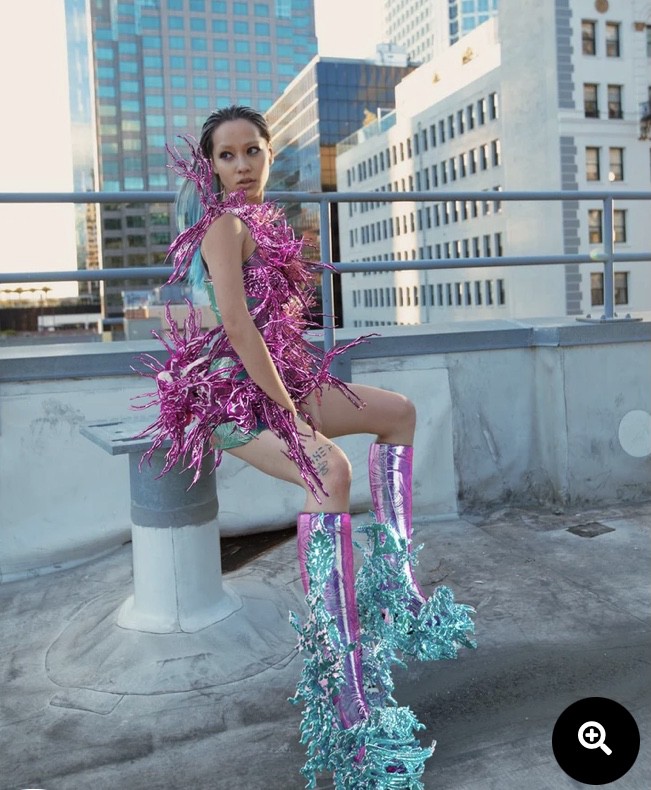As times change, so does fashion. It is widely known that the fashion industry is always evolving and with the constant development of technological trends, fashion goes with it. The fashion industry already changed to a more sustainable and customer-focused area as virtual fitting rooms were put into practice and new ways of producing clothing were developed (Cheuck, 2022). But now a whole new part of the fashion industry is big business: digital clothing.
Digital clothing are virtually designed clothes especially made using 3D software and computer technologies. These clothes are made of pixels rather than textiles and are designed for both humans and avatars. In the digital world the possibilities are endless, creating the opportunity to design clothing that would not be possible in the physical world (Stephenson Law, 2022). Secondly, it makes buying clothing much easier. People do not have to think about if and how it fits, if the product is ethical and how it looks (Santos, 2021).
As the Metaverse expands, everyone will soon have a digital copy of themselves, making it possible for the digital fashion to play a significant role in how we create our virtual selves. If you want to look good in the physical world, so must your avatar in the online world. In March the first Metaverse Fashion Week took place where big names as Tommy Hilfiger and Dolce & Gabbana showed their digital clothing. Besides existing (physical) brands, also Web3.0 brands Fang Gang and DeadFellaz offer digital clothing (Stephenson Law, 2022).
However, digital fashion is not only limited to dress up your avatar in games or in the Metaverse. Digital clothes can also be sold as NFT’s (non-fungible tokens). You only need to upload a picture and choose the digital garment you would like to buy. After your payment, you will receive your picture with the digital clothing item portrayed on your body (Stephenson Law, 2022). In this way, designers of digital clothing can authenticate the original ownership of their creations and also receive payments when they sell a piece (Nguyen, 2022).
Although it may seem that digital fashion is the next big thing when it comes to sustainable fashion, it cannot be seen as a substitute for physical clothing. Not to forget that NFT’s have their own way of polluting the environment. Nevertheless, it can be a nice addition to the items in your closet in the battle against fast fashion (Nguyen, 2022).
References:
Cheuck, L. (2022). Boutiques in Your Phones: How Has Technology Changed the Fashion Industry? Jumpstart Magazine. Retrieved from: https://www.jumpstartmag.com/how-has-technology-changed-the-fashion-industry/
Nguyen, T. (2022). What’s the point of digital clothes? VOX. Retrieved from: https://www.vox.com/the-goods/22893254/digital-fashion-metaverse-real-clothes
Santos, R. (2021). People Are Buying Digital Clothes Because That’s a Thing Now. VICE. Retrieved from: https://www.vice.com/en/article/akvzqz/virtual-digital-clothes-fashion-game-skins-metaverse
Stephenson Law. (2022). Digital Fashion: What is it? Where Did it Come From? And Where is it Going? Stephenson Law. Retrieved from: https://www.stephenson.law/blog/digital-fashion-what-is-it-where-did-it-come-from-and-where-is-it-going


Interesting topic! I do find it a little hard to wrap my head around. How would digital clothing stop fast fashion? I understand the copying of IP, but would it have an ecological impact? Would love to hear your take on this!
Nice post! It’s fascinating to see how digital apparel is being marketed in the context of fashion. It’s also interesting to think about how people will navigate it and what facets of style, personality, and self-expression stand out because it can be extremely diverse. However, it is kind of gimmicky to me because, as you write, it cannot be seen as a substitute for physical clothing. I think digital clothing will probably be used in a few types of industries, and in order to be successful, it will need to be combined with other elements. For instance, you might be required to wear a “uniform” to establish that you are a registered student if you want to visit a school’s official campus in the Metaverse for class. Or you will need to wear a fancy digital gown to virtual galas, etc…
Really nice blog, did not know a lot about it so far. I’m very intersted in where this will go and do like the sustainable side to it. I do think that it is very important to be sustainable and this will probably be a big opportunity for that in the future. Curious to how this will develop!